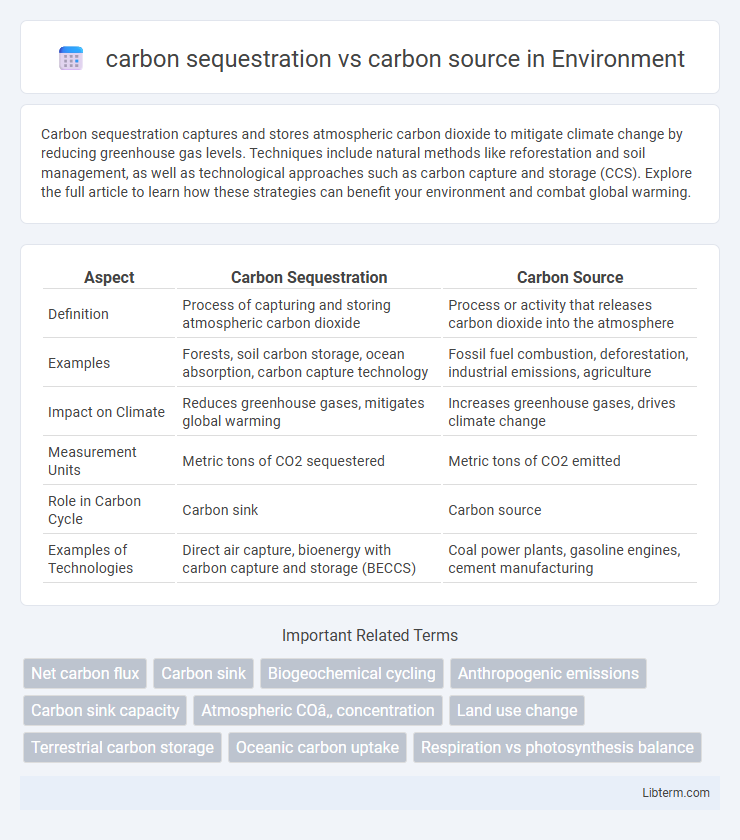Carbon sequestration captures and stores atmospheric carbon dioxide to mitigate climate change by reducing greenhouse gas levels. Techniques include natural methods like reforestation and soil management, as well as technological approaches such as carbon capture and storage (CCS). Explore the full article to learn how these strategies can benefit your environment and combat global warming.
Table of Comparison
| Aspect | Carbon Sequestration | Carbon Source |
|---|---|---|
| Definition | Process of capturing and storing atmospheric carbon dioxide | Process or activity that releases carbon dioxide into the atmosphere |
| Examples | Forests, soil carbon storage, ocean absorption, carbon capture technology | Fossil fuel combustion, deforestation, industrial emissions, agriculture |
| Impact on Climate | Reduces greenhouse gases, mitigates global warming | Increases greenhouse gases, drives climate change |
| Measurement Units | Metric tons of CO2 sequestered | Metric tons of CO2 emitted |
| Role in Carbon Cycle | Carbon sink | Carbon source |
| Examples of Technologies | Direct air capture, bioenergy with carbon capture and storage (BECCS) | Coal power plants, gasoline engines, cement manufacturing |
Introduction to Carbon Sequestration and Carbon Sources
Carbon sequestration involves the process of capturing and storing atmospheric carbon dioxide to reduce greenhouse gases and mitigate climate change. Carbon sources, such as fossil fuel combustion, deforestation, and industrial activities, release significant amounts of CO2 into the atmosphere, contributing to global warming. Enhancing natural carbon sinks like forests, soils, and oceans through sequestration techniques is crucial for balancing emissions from these carbon sources.
Defining Carbon Sequestration: Mechanisms and Methods
Carbon sequestration involves capturing and storing atmospheric carbon dioxide through biological, chemical, and physical processes to mitigate climate change. Key mechanisms include photosynthesis in forests and oceans, soil carbon storage, and technological methods like direct air capture and carbon mineralization. Unlike carbon sources that release CO2 into the atmosphere, sequestration aims to reduce greenhouse gas concentrations and enhance long-term carbon storage stability.
Understanding Carbon Sources: Natural and Anthropogenic Origins
Carbon sources release carbon dioxide into the atmosphere through natural processes like respiration, volcanic activity, and decomposition, as well as anthropogenic activities such as fossil fuel combustion, deforestation, and industrial processes. Understanding the balance between these natural and human-induced carbon sources is crucial for managing climate change and tracking global carbon cycles. Accurate measurement and monitoring of carbon emissions enable effective strategies for reducing carbon footprints and enhancing carbon sequestration efforts.
Key Differences Between Carbon Sequestration and Carbon Sources
Carbon sequestration involves the process of capturing and storing atmospheric carbon dioxide through natural methods such as forests, soil, and oceans, or artificial techniques like carbon capture and storage (CCS). Carbon sources refer to activities or processes that release carbon dioxide or other greenhouse gases into the atmosphere, including fossil fuel combustion, deforestation, and industrial processes. The key difference lies in their impact on atmospheric carbon levels: carbon sequestration reduces greenhouse gases, mitigating climate change, while carbon sources increase greenhouse gas concentrations, contributing to global warming.
The Role of Carbon Cycle in Balancing Emissions
Carbon sequestration plays a critical role in the carbon cycle by absorbing atmospheric CO2 through natural processes like photosynthesis and soil carbon storage, effectively reducing greenhouse gas concentrations. In contrast, carbon sources such as fossil fuel combustion and deforestation release stored carbon back into the atmosphere, increasing emissions. The balance between these carbon sinks and sources governs global carbon fluxes, directly influencing climate stability and emission reduction efforts.
Impact of Carbon Sources on Global Warming
Carbon sources, such as fossil fuel combustion and deforestation, release significant amounts of carbon dioxide into the atmosphere, intensifying the greenhouse effect and accelerating global warming. Increased atmospheric CO2 enhances heat retention, leading to climate disruptions such as rising temperatures, melting ice caps, and extreme weather events. Mitigating these emissions is critical to limiting global temperature rise and ensuring climate stability.
Carbon Sequestration Techniques: Biological, Geological, and Technological
Carbon sequestration techniques capture and store atmospheric CO2 to mitigate climate change by offsetting carbon sources such as fossil fuel combustion and deforestation. Biological methods use forests, soils, and wetlands to absorb and retain carbon naturally, enhancing ecosystem carbon sinks. Geological sequestration involves injecting CO2 into deep underground rock formations, while technological options include direct air capture and carbon capture and storage (CCS) systems at industrial sites.
Evaluating the Effectiveness of Carbon Sequestration Initiatives
Evaluating the effectiveness of carbon sequestration initiatives involves measuring the amount of CO2 captured and stored compared to emissions released by carbon sources within the same ecosystem or industrial process. Key metrics include storage permanence, sequestration rate, and life cycle emissions analysis to ensure net carbon removal. Technologies such as afforestation, biochar application, and geological storage require continuous monitoring and verification to validate their impact on reducing atmospheric carbon levels.
Challenges in Reducing Carbon Sources and Enhancing Sequestration
Reducing carbon sources faces challenges such as the reliance on fossil fuels, industrial emission intensity, and economic constraints limiting rapid transitions to renewable energy. Enhancing carbon sequestration is hindered by the limited capacity of natural sinks like forests and oceans, technological scalability issues in direct air capture, and uncertainties in long-term storage permanence. Effective climate strategies require addressing these complexities to balance emission reductions with increased carbon capture.
Future Strategies for Managing Carbon Balance
Future strategies for managing carbon balance emphasize enhancing carbon sequestration methods, such as afforestation, soil carbon storage, and blue carbon ecosystems, to offset increasing emissions from carbon sources like fossil fuel combustion and deforestation. Advanced technologies like direct air capture and bioenergy with carbon capture and storage (BECCS) are critical for reducing atmospheric CO2 levels. Integrating these approaches with policy incentives and sustainable land management ensures a balanced carbon cycle and mitigates climate change impacts.
carbon sequestration Infographic

 libterm.com
libterm.com